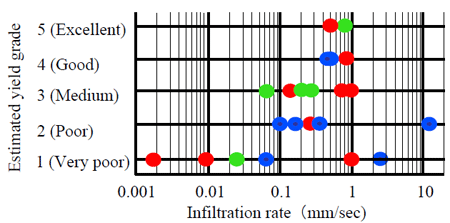Runoff of nutrients cause decreasing crop yield in fields with lower infiltration rates in Southern Mali
Description
In Southern Mali, over a distance of approximately 300 km, or for every 2˚ difference in latitude, annual precipitation has decreased within the recent few decades by 600 mm, from 1,400 mm to 800 mm. Local farmers tend to believe that the reduction in precipitation is the only cause of recently decreasing and unstable crop production. However, we were able to demonstrate that runoff of fertilizer elements due to precipitation decreased crop yield in fields with low infiltration rates in the region. The research was conducted with budgetary support from the Japanese Ministry of Education over a period of three years from 2000.
The region is located on one of the old geological plates, where soils have become divided into two distinct types during its long history. The first type is gravelly soil, with a high infiltration rate, located mainly in highland areas where erosion occurs. The other type is clayey soil, with a low infiltration rate, located mainly in lowland areas, where deposition occurs. In the first type of soil, rainwater infiltrates rapidly into the subsoil, while in the second type, there is considerable rainwater runoff from the soil surface.
We hypothesized that either type of water movement could cause loss of nutritive elements and thereby result in reduced yield. We tested this hypothesis first by examining the infiltration rate. Analysis showed that, from the beginning of the rainy season, at least 614 mm of precipitation and 90 days were needed before the water capacity of the soil at a depth of 60 cm was completely filled (Fig. 1).
According to our results, over 90% of the water from precipitation was calculated to be lost due to soil surface runoff and evaporation. Growth of maize, millet, sorghum and cotton was visually estimated from standing plants, and was analyzed in terms of its relationship with the infiltration rates in twenty-one fields in Diou. For measurement of the infiltration rate, a cylinder 20 cm2 in cross section and 10 cm in height was inserted into the soil to a depth of 2.5 cm, after which water was poured into the cylinder to a height of 5 cm. Crop growth was poor in fields where infiltration rates were either much lower than the average range, at under 0.04 mm/sec or much higher at over 1.00 mm/sec (Fig. 2).
Root distribution maps of maize were drawn from three fields with low, medium, and high infiltration rates, respectively. Crops in fields with soils with low infiltration rates showed signs of mild water stress early in the cropping period. Crops in fields with soils showing high infiltration rates gave signs of restricted root development later in the cropping period. These results show that runoff of water and nutritive elements from the soil surface, as well as leaching into the subsoil, collectively result in poor growth.
To verify the above hypothesis experimentally, effects on cotton yield of quick-acting and slow-acting fertilizers were compared. Cotton yield in plots receiving slow-acting fertilizer were higher in fields with soils showing lower infiltration rates (Table 1). This shows that the lack of nutritive elements due to rainwater runoff on the soil surface decreased water use efficiency in fields with lower infiltration rates, even in this region where a general water shortage already limits crop production.
Practices to decrease nutritive element runoff on soil surfaces, including split application of fertilizer, construction of levees surrounding fields, and drainage canals could be useful in fields with lower infiltration rates. The infiltration rates of 12% of fields in the region were under 0.04 mm/sec.
Figure, table
-
-
-
Table 1. Effects of additional application of urea and coated urea on cotton ball yield in fields with different infiltration rates.
- Affiliation
-
Japan International Research Center for Agricultural Sciences Okinawa Subtropical Station
- Classification
-
Technical A
- Term of research
-
FY2000~2002、FY2003
- Responsible researcher
-
OZAWA Kiyoshi ( Development Research Division )
CALDWELL John S. ( Development Research Division )
SASAKI Kaori ( Tohoku Agricultural Research Center, NARO )
KANNO Hiromitsu ( Tohoku Agricultural Research Center, NARO )
DOUMBIA Mamadou ( Mali's Institute of Rural Economy )
YOROTE Abdouramane ( Mali's Institute of Rural Economy )
BERTHE Abou ( Mali's Institute of Rural Economy )
- ほか
- Publication, etc.
-
Caldwell J. S., Kannno H., Berthe A., Yorote A., Sasaki K., Doumbia M., Ozawa K. and Sakurai S. (2002): Climate Variability in Cereal-based Cropping Systems in Mari, West Africa, Farming Japan 36, 35-41
Ozawa K. and Doumbia M., Low infiltration decreases the availability of precipitation in Mali. In Eds. Caldwell J. S. et.al Supporting Farmer Dcisions in Response to Climatic Risk. JIRCAS Working Report 49, 38-44
- Japanese PDF
-
2005_seikajouhou_A4_ja_Part24.pdf615.79 KB



